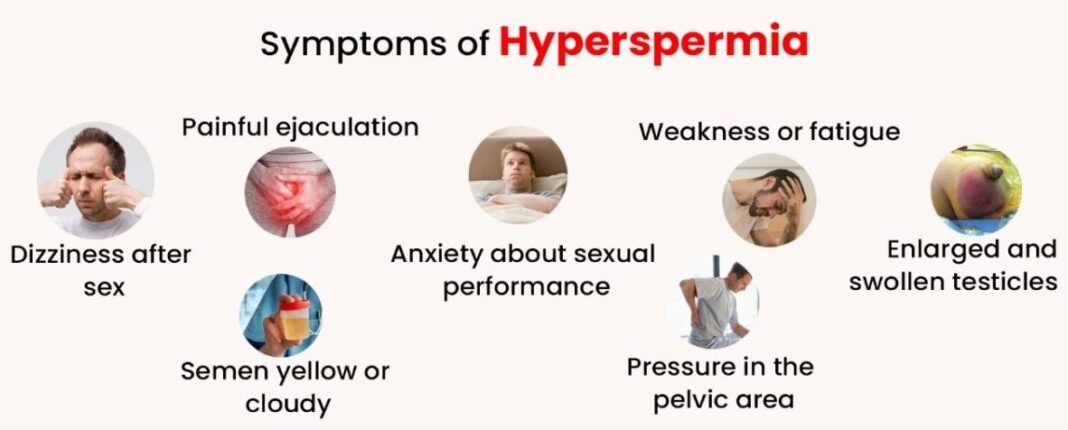Hyperspermia refers to a condition where a male produces an unusually high volume of semen during ejaculation. While this might sound surprising, it’s important to understand the implications, causes, and potential effects on fertility and health. In this comprehensive guide, we’ll explore everything you need to know about, from its definition and symptoms to its diagnosis and treatment options.
What is Hyperspermia?
Hyperspermia is characterized by a semen volume greater than the normal range, which is typically between 1.5 to 5 milliliters per ejaculation. When a man produces more than 5 milliliters, this is considered. This condition is often diagnosed during a semen analysis, which is a common test for men undergoing fertility evaluations.
Symptoms of Hyperspermia
Most men with hyperspermia do not experience noticeable symptoms. However, some may report changes in their sexual function or discomfort during ejaculation. Other possible signs might include:
- Increased ejaculation volume: A clear indicator of hyperspermia.
- Changes in libido: Some men may notice fluctuations in their sexual drive.
- Discomfort: Rarely, some men may experience mild pain during ejaculation.
If you notice any significant changes in your ejaculate volume or sexual function, it’s essential to consult a healthcare professional.
Causes of Hyperspermia
The causes of hyperspermia can vary widely, from lifestyle factors to medical conditions. Here are some common causes:
1. Hormonal Imbalances
Hormones play a crucial role in sperm production. An imbalance in hormones, particularly testosterone, can lead to increased semen volume. Conditions affecting the pituitary gland or hypothalamus may also contribute to hormonal changes.
2. Prostate Health
The prostate gland contributes a significant portion of the fluid in semen. Conditions like prostatitis (inflammation of the prostate) or benign prostatic hyperplasia (BPH) can affect prostate health and potentially lead to hyperspermia.
3. Frequency of Ejaculation
Men who engage in frequent sexual activity or masturbation may experience temporary increases in semen volume. The body might compensate by producing more seminal fluid.
4. Genetic Factors
Some studies suggest that genetic predispositions can influence semen volume. Men with a family history of reproductive issues might be more likely to experience hyperspermia.
5. Diet and Lifestyle Choices
Certain lifestyle choices, including diet, smoking, and excessive alcohol consumption, can affect overall reproductive health and lead to increased semen production.
Diagnosis of Hyperspermia
If you suspect you have hyperspermia, a healthcare provider will typically conduct a semen analysis. This test measures:
- Semen volume: To determine if it exceeds normal levels.
- Sperm count: To assess sperm concentration and overall fertility.
- Sperm motility: To evaluate how well sperm move.
- Sperm morphology: To examine the shape and structure of sperm.
When to Seek Medical Advice
If you experience symptoms like pain during ejaculation or any other concerns about your sexual health, it’s crucial to consult a healthcare professional. They can provide a proper evaluation and determine if further tests or treatments are necessary.
Treatment Options for Hyperspermia
Treatment for hyperspermia largely depends on the underlying cause. Here are some potential approaches:
1. Lifestyle Modifications
Making changes to your lifestyle can significantly improve overall reproductive health. Consider:
- Healthy Diet: Focus on a balanced diet rich in fruits, vegetables, whole grains, and healthy fats.
- Regular Exercise: Engage in physical activity to promote overall health and hormone balance.
- Avoiding Substance Abuse: Limit alcohol consumption and avoid smoking or recreational drugs.
2. Medical Treatment
If hormonal imbalances or prostate issues are contributing to hyperspermia, your healthcare provider may recommend specific treatments. These could include:
- Hormone Therapy: To correct any imbalances.
- Medications: To address prostate health or other underlying conditions.
3. Counseling and Support
For men who experience anxiety or emotional distress related to hyperspermia, counseling or therapy can be beneficial. A mental health professional can provide support and coping strategies.
Conclusion
BOURSESSENEGAL – Hyperspermia is a condition that affects a man’s semen volume and can be influenced by various factors, including hormonal imbalances, lifestyle choices, and prostate health. While it might not always indicate a serious issue, understanding the condition and its implications is essential. If you have concerns or notice changes in your reproductive health, consult a healthcare professional for proper evaluation and treatment options. By taking proactive steps, you can maintain your overall health and well-being.
FAQs About Hyperspermia
What is the normal volume of semen during ejaculation?
The normal range is typically between 1.5 to 5 milliliters.
Can hyperspermia affect fertility?
While hyperspermia itself doesn’t typically affect fertility, it can be a sign of underlying issues that may impact reproductive health.
Is hyperspermia common?
Hyperspermia is less common than conditions like oligospermia (low sperm count) but can occur in certain individuals.
If you experience any symptoms or have concerns, it’s best to consult a healthcare professional for guidance.
By understanding hyperspermia, you empower yourself with knowledge and can take charge of your reproductive health. Whether through lifestyle changes or medical interventions, there are options available to help you navigate this condition effectively.
REFERENCE : https://www.cdcfoundation.org/



